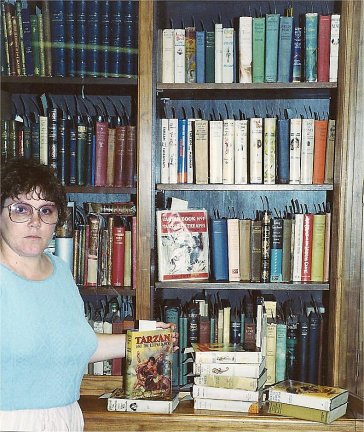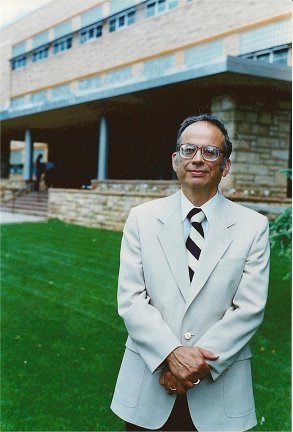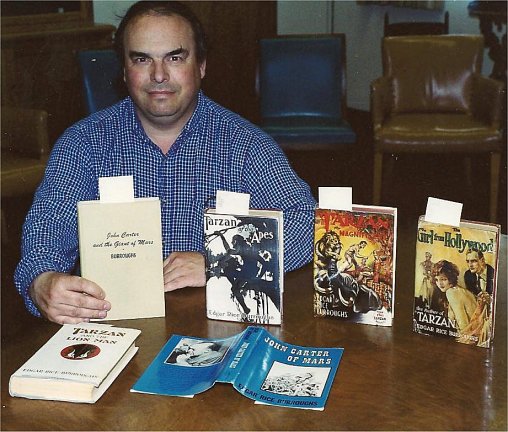Wherever people are from, if they stand at all in awe of the
Creation, they are likely to refer to their own neck of the woods as "God's
Country." This is not so much conceit as it is a simple statement of truth.
For if God created all, then all is, indeed, God's Country.
To a lesser degree, some regions of this world are sometimes referred
to by the names of more bantam beings. During the Peanut Presidency, a
short-lived TV sitcom described the South as "Carter Country." A more compact
section of the South may be known as something like "Cajun Country." Walt
Disney made a short feature several years ago titled "Bear Country." Signs
inside the gymnasiums of high schools might attempt to intimidate opponents
by proclaiming "You're in Tiger Country," or whatever the local mascot
happens to be.
So, from God's Country on down, the term "country" is often used to
apply to an area that is associated with a particular people, individual
or theme.
Where, then, is Edgar Rice Burroughs Country?
Is it the environs of Tarzana, California, the town which Burroughs
founded and nurtured so many years? Could it be Chicago, where he
was born and spent his formative years and began his professional writing
career? Might it be the jungles of Africa, where Tarzan roams,
or the dead sea bottoms of Mars, where green Martians astride thoats
ride in search of adventure? Could it be Arizona, where Burroughs
rode with the 7th Cavalry, or the headwaters of the Little Colorado
in that same state, where John Carter regaled his nephew with stories
of Barsoom?
All of these areas, and more could well be dubbed "Edgar Rice Burroughs
Country."
I had the pleasure of visiting a portion of Edgar Rice Burroughs Country
on my summer vacation. In this particular case, Edgar Rice Burroughs Country
is made up of the states of Washington, Montana, Wyoming, Colorado
and Idaho. While it may be obvious in the case of Idaho why it can
be referred to as Edgar Rice Burroughs Country, what about the other places?
As I began my trip through these areas this summer, I did not think of
myself as being about to travel through Edgar Rice Burroughs Country, but
as I went along, I realized that was exactly where I was. This is why:
Washington is Edgar Rice Burroughs Country
The Evergreen State is deserving of the ERB appellation for no other reason
than that it is my home, and I am an Edgar Rice Burroughs fan. It is in
my Centralia, Wash., home that I have my collection of ERB books and related
memorabilia, and where I sometimes have the pleasure of entertaining Burroughs
fans from (so far) other parts of Washington, British Columbia and
California.
For the past three years, the rest of this year and, I imagine, for
at least another year after that, Washington is the home of the Official
Editor of ERB APA (Edgar Rice
Burroughs Amateur Press Association). I did that work for two and a
half years and my friend, Alan Hanson, of Spokane, is now
in his first term as editor and running (unchallenged most likely) for
a second. I know there are other Burroughs fans in this state, too, and
I can hope to meet them someday. Our knowledge of each other's existence
will only strengthen our claim to be part of Edgar Rice Burroughs Country.
Montana is Edgar Rice Burroughs Country
I don't know if Burroughs ever set foot in the Treasure State, but his
aura is there nonetheless.
When I planned my summer vacation around the fact that the Edgar
Rice Burroughs Chain of Friendship (ECOF)
gathering was to take place in Denver, Colorado, I originally figured
on heading south and crossing over to Colorado through lower Idaho and
Wyoming. But when a nephew called up to tell me he had moved to Red
Lodge, Montana, and was planning to be married there on the first weekend
of my vacation, I decided to head that way instead.
Even then, I didn't plan on visiting the Little Bighorn Memorial
Battlefield, 54 miles south of Billings, until my mother --
who had been there -- suggested it.
She also told me that some distant relatives operated the store and
post office at the small town of Garry Owen, near the battlefields.
Garry Owen took its name from the theme song of the 7th Cavalry,
the unit which rode into history at the Little Bighorn. My mother indicated
that these distant relatives were, in fact, so distant that they might
even act a little distant if I stopped in their store to introduce myself.
And so, I ended up at the Little Bighorn Battlefield later in the day,
after my nephew was officially married.
This is the type of place I believe Alan Hanson would enjoy. Alan once
wrote an ERBapa series called "The Burroughs Battles," in which
he detailed the various engagements which Burroughs wrote of. As Alan opened
his series in ERBapa 5, he said, "There is something sublime about walking
the ground of an old battlefield."
Alan said he was speaking thus mainly in reference to the old battlefields
where men fought hand to hand rather than at arrow or rifle range. But
although those two weapons were in use as Little Big Horn, there was no
doubt some of the eyeball-to-eyeball stuff as well.
I had never knowingly visited a real battlefield before, and there is
a certain mystique about it. As a National Park Service-managed area, there
were interpretive displays, a museum, charts, lectures, etc., all over
the place, so it was easy to find one's way about.
The five-mile-long field of battle is sporadically sprinkled with small
white tombstones at the spot where each cavalryman fell and was originally
buried, though all bodies have since been moved, some to other cemeteries
and the rest to a mass grave near the battlefield entrance.
Once can stand on a small hill and look down a few feet to where Custer
and the bulk of his command died; one can picture the Indians coming
up the hill on foot and circling around behind it on their ponies. Further
back, one sees the broad plain and river, where hundreds of teepees stood
that day and where Interstate 90 stretches now.
But why is this Edgar Rice Burroughs Country?
One reason is that Burroughs himself later wrote about Indians
vs. cavalry, although the scene was the Southwest rather than
Montana. And Burroughs presented the Indians in a more sympathetic light,
just as modern analyses of the Little Big Horn tragedy tend to paint the
Indians as more victims than villains.
I don't pretend to understand Little Big Horn. The Park Service book
shop stocks dozens of volumes, examining what happened from all points
of view and prejudices. I chose one recent book, Son of the Morning
Star by Evan S. Connell, as one that looks like it is a pretty
balanced treatment. My other purchase was a Park Service book detailing
what happened, not necessarily why it happened.
The other reason that this became, for me, Edgar Rice Burroughs Country
was that Burroughs himself became a member of the 7th Cavalry. But no glory
attended his enlistment; it was lackluster and without distinction, and
served at a faraway "boring" outpost in Arizona, not Montana.
Yet, as a member of such a unit, young Ed was no doubt familiar with
the legacy of the outfit, just as recruits in boot camp today are instilled
with military tradition and history and learn to recite facts about great
battles and heroes upon command.
As well read and knowledgeable about the world around him as Edgar Rice
Burroughs was, I imagine that he knew quite a bit about Custer and the
Battle of Little Big Horn. Did it influence any of his tales of cavalry
and Indians on this planet or in disguise on other planets? And I've often
wondered if Burroughs took the name of an ill-fated 7th Cavalry commander
and applied it to a later hero. Historians say Custer always thought he
would be president some day. Well, a later Burroughs hero named Custer
did not become a president, but did become a king.
We drove from the battlefield as dusk settled, through the gate and
down the road past all the Indian teepees where modern day entrepreneurs
sell genuine Indian souvenirs and turquoise jewelry to the tourists. We
hit Interstate 90 and continued south and, because we wanted to make Sheridan,
Wyoming, in time to get a motel, we didn't take the Garry Owen exit
to see my distant relatives.
But I smiled as I drove by.
Colorado is Edgar Rice Burroughs Country
Colorado has the same distinction that Washington has: Edgar Rice Burroughs
fans live here. And this summer, there were more of them in the state than
usual as they gathered for the annual ECOF meeting at Denver's Oxford
Hotel.
This was just the second Burroughs gathering I have attended. The first,
in Tarzana, California, in 1989, was packed with people and special activities.
The one in Colorado was different, perhaps a lot like the earlier ECOF
events that I had only read about in fanzines. Just a few people came to
this one, but about half of them were members of ERBapa. It was a good
opportunity to visit individuals longer and get to know them better.
One illustration of this is the fact that I met Laurence
Dunn of South Croydon, Surrey, England at ECOF '89. Later, when
Laurence wrote to me as O.E. of ERBapa to purchase some copies, I wrote
back and told him that I remembered meeting him. But Laurence just couldn't
remember meeting me!
So, three years later I and my wife walked into the Oxford Hotel and
I spotted Laurence just as my wife started asking him directions. "Wait
a minute," I said. "I know this guy."
Laurence looked a bit taken aback at this stranger who claimed to know
him. But puzzlement turned to smiles a moment later as I told him my name.
This time we had a good visit and we'll both remember each other.
Laurence wrote me the other day and said, "At last I can say that we
have definitely met -- and that this time I can remember it! When your
wife asked me directions . . . as we stood on top of the stairs, and you
said that you knew me, but I didn't know you, I felt certain that you had
confused me with somebody else! After all, I had only just arrived in the
States myself -- who could possibly know me in Denver?
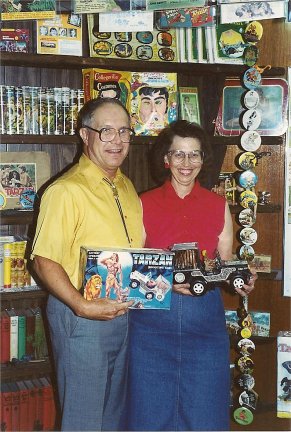 "Anyway,
it was good to see you and have a chance to chat this time around -- so
much better than a lost handshake somewhere along the line!"
"Anyway,
it was good to see you and have a chance to chat this time around -- so
much better than a lost handshake somewhere along the line!"
While in Denver, we spent two great evenings visiting with Roy and
Dela White and appreciating their collection, which lines the walls
of their basement Burroughs room.
We had met Roy and Dela at Tarzana and gotten along well with them,
so we made sure to look them up when we arrived in Denver. Roy and Dela
have been doing some serious collecting the past few years and their
efforts have paid off in the acquisition of lots of great books and plenty
of related things, including toys, posters, and collectibles too varied
and numerous to list.
It was a good chance to meet some ERBapa members for the first time.
At last I made the acquaintance of Bob
Hyde, a senior member of the APA and of ERB fandom at large as well,
and I shook hands for the first time with new ERBapa members David Robbins
of Berthoud, Colorado, and George Alonso of Minden, Nebraska.
John McQuigan hosted the event this year and took the occasion
to hand out copies of the latest issue of Tarzine to any there who
were subscribers. Other APA members present were Mike
Conran, Bill Ross,
Ken Webber, Alan Hanson and honorary member Danton
Burroughs.
Bob Hyde was honored with the Edgar Rice Burroughs Lifetime Achievement
Award, an honor well deserved.
Wyoming is Edgar Rice Burroughs Country
Wyoming is one of several western states, the mention of whose name
immediately brings to mind a picture of the Old West, cowboys, Indians,
and so forth. There are towns like Cheyenne, named for the Indian
tribe, and towns like Sheridan, named for the men who fought the
Indians. Cheyenne was also a TV western, as was Laramie.
John Colter, Buffalo Bill, Butch Cassidy and the Sundance Kid
all rode here.
And the state is a geological playground, from Yellowstone and
Old
Faithful in the west to Devil's Tower -- a feature made famous
in the film "Close Encounters" -- in the east.
Its entire population, 450,000, is less than that of some major U.S.
cities. Wyoming has so few people, according to one of its residents, Gene
Gressley, that "You don't talk to somebody about someone else because
you're probably talking to their cousin."
One of the 450,000, Gene Gressley enjoyed reading Edgar Rice Burroughs
books as a lad and also appreciated the screen characterization of Johnny
Weissmuller. Thanks to Gene, the works of Edgar Rice Burroughs will always
be a part of the University of Wyoming department of special collections.

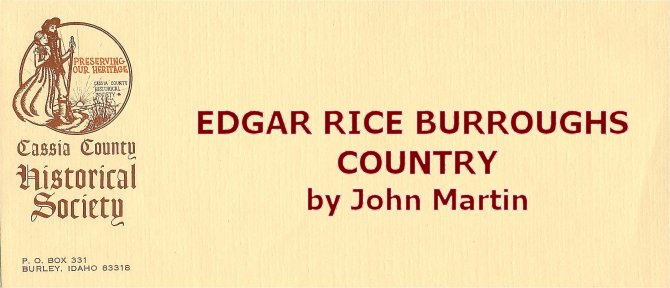
 "Anyway,
it was good to see you and have a chance to chat this time around -- so
much better than a lost handshake somewhere along the line!"
"Anyway,
it was good to see you and have a chance to chat this time around -- so
much better than a lost handshake somewhere along the line!"
